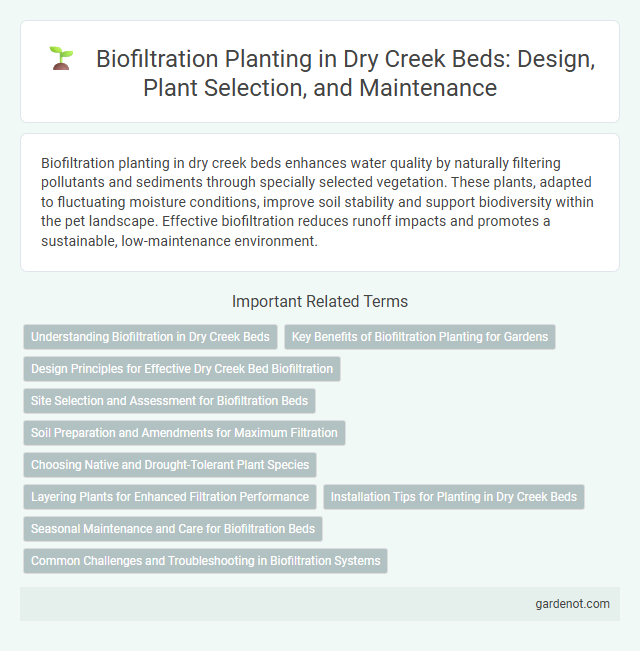Biofiltration planting in dry creek beds enhances water quality by naturally filtering pollutants and sediments through specially selected vegetation. These plants, adapted to fluctuating moisture conditions, improve soil stability and support biodiversity within the pet landscape. Effective biofiltration reduces runoff impacts and promotes a sustainable, low-maintenance environment.
Understanding Biofiltration in Dry Creek Beds
Biofiltration in dry creek beds utilizes specific plants to naturally filter pollutants and improve water quality by trapping sediments and absorbing contaminants. Native grasses, sedges, and shrubs are commonly selected for their deep root systems that enhance soil stability and facilitate microbial activity. This process creates an effective, sustainable filtration system that supports ecosystem health and reduces stormwater runoff pollution.
Key Benefits of Biofiltration Planting for Gardens
Biofiltration planting in dry creek beds enhances water purification by filtering pollutants and sediments, promoting healthier garden ecosystems. These plants improve soil stability and reduce erosion, ensuring long-term landscape durability. Incorporating native vegetation also supports local biodiversity and reduces maintenance needs by adapting to the natural water flow and climate conditions.
Design Principles for Effective Dry Creek Bed Biofiltration
Effective dry creek bed biofiltration design incorporates native, drought-tolerant plants with deep root systems to enhance soil permeability and pollutant uptake. Incorporating a graded slope between 2-5% facilitates controlled water flow, maximizing infiltration and sediment capture while minimizing erosion. Strategic placement of vegetation in zones of variable moisture supports microbial activity and nutrient cycling essential for long-term water quality improvement.
Site Selection and Assessment for Biofiltration Beds
Site selection for biofiltration beds in dry creek beds requires assessing soil permeability, existing vegetation, and hydrological patterns to ensure effective water infiltration and pollutant removal. Ideal sites exhibit well-drained soils with moderate infiltration rates that prevent standing water while supporting native biofiltration plant species. Evaluating factors such as slope gradient, sunlight exposure, and proximity to pollutant sources enhances the design and performance of biofiltration planting in dry creek bed environments.
Soil Preparation and Amendments for Maximum Filtration
Soil preparation in biofiltration planting for dry creek beds involves thorough aeration and incorporation of organic matter to enhance soil structure and permeability. Amendments like compost and biochar improve nutrient retention and microbial activity, boosting filtration efficiency. Optimizing soil texture with sand or loam additions promotes better water infiltration and contaminant breakdown, ensuring maximum pollutant removal.
Choosing Native and Drought-Tolerant Plant Species
Selecting native and drought-tolerant plant species for biofiltration in a dry creek bed enhances water absorption and reduces soil erosion while supporting local biodiversity. Plants such as blue grama grass, desert willow, and California poppy thrive in low-water conditions and stabilize sediment effectively. These species improve water quality by filtering pollutants naturally and require minimal irrigation once established.
Layering Plants for Enhanced Filtration Performance
Layering plants in dry creek beds creates a multi-tiered vegetation structure that enhances biofiltration by maximizing pollutant uptake and sediment capture. Combining deep-rooted species with ground covers and shrubs improves soil stability and water infiltration rates, effectively reducing runoff contaminants. Selecting native, drought-tolerant plants such as sedges, rushes, and willows optimizes filtration performance while supporting local ecosystems.
Installation Tips for Planting in Dry Creek Beds
Select drought-tolerant native plants such as sedges, rushes, and ornamental grasses that thrive in dry creek bed conditions for biofiltration planting. Prepare the soil by loosening it to improve infiltration and incorporate organic matter to enhance water retention while preventing erosion. Space plants according to their mature size and install biodegradable erosion control mats around roots to stabilize the creek bed during establishment.
Seasonal Maintenance and Care for Biofiltration Beds
Seasonal maintenance for biofiltration beds in dry creek beds involves regular removal of sediment and debris to sustain optimal water flow and filtration efficiency. Plant care includes monitoring native vegetation for health, replacing senescent or invasive species, and ensuring adequate moisture during dry periods to promote root stability and pollutant uptake. Routine inspection after heavy rainfall events prevents clogging and supports long-term soil infiltration and ecosystem resilience.
Common Challenges and Troubleshooting in Biofiltration Systems
Biofiltration systems in dry creek beds often face challenges such as clogging due to sediment accumulation and inadequate plant establishment caused by fluctuating moisture levels. Proper selection of drought-tolerant native plants like Carex and Juncus species, along with regular maintenance to remove sediment and manage hydrology, is essential to optimize filtration efficiency. Monitoring nutrient loads and soil conditions helps prevent system failure and ensures sustained pollutant removal performance.
Biofiltration planting Infographic

 gardenot.com
gardenot.com